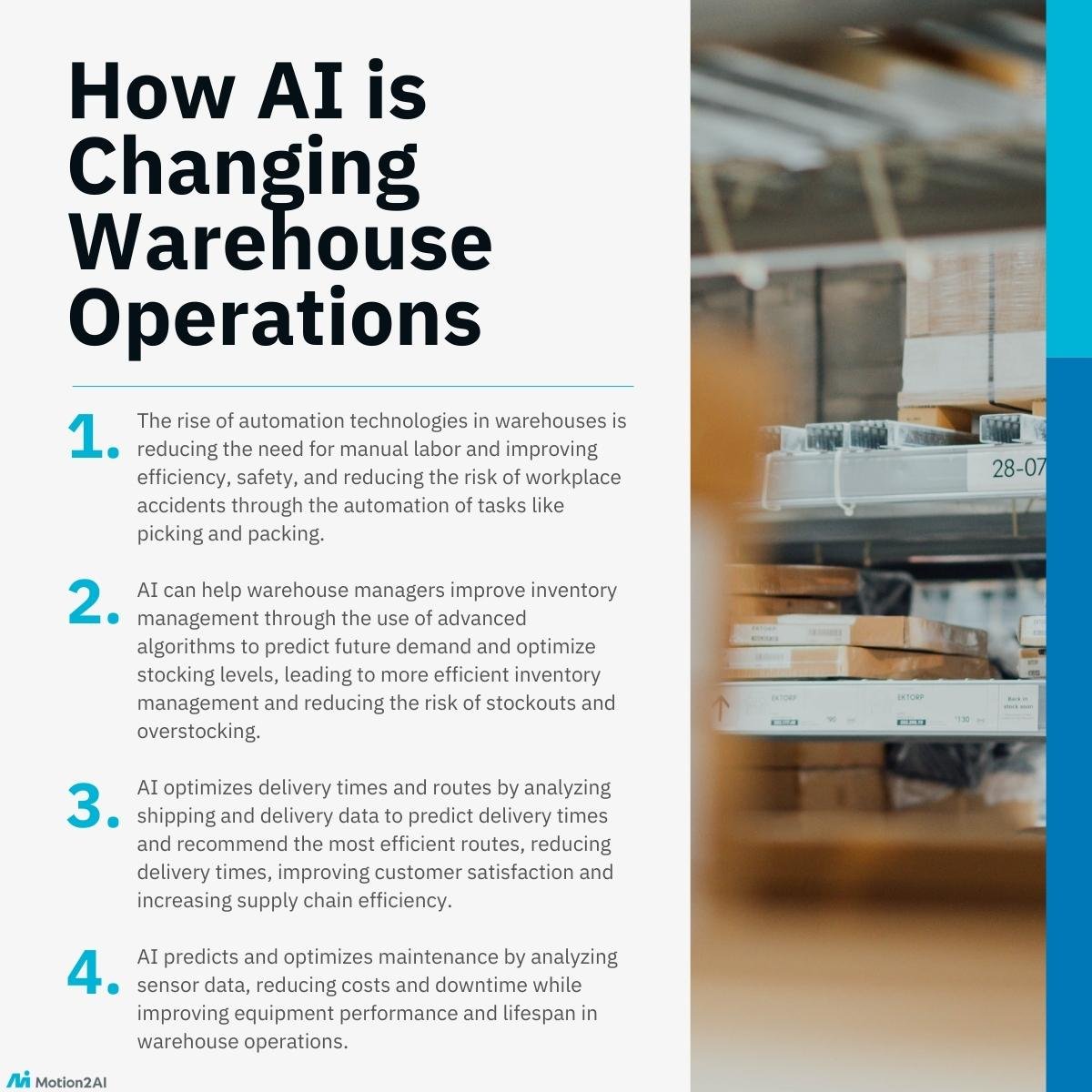Artificial Intelligence (AI) is a rapidly growing field with the potential to revolutionize many industries, and warehouse operations are no exception. In recent years, AI has been making its way into the world of logistics and supply chain management, bringing with it a wide range of benefits that can help companies to optimize their operations, increase efficiency, reduce costs, and improve customer satisfaction.
With the rise of automation technologies such as robotic process automation (RPA) and industrial robots, warehouses are becoming increasingly automated, reducing the need for manual labor and freeing up workers to focus on more strategic tasks. This not only reduces labor costs, but also helps to improve safety and reduces the risk of workplace accidents.
Companies can use robotic arms to automate the picking and packing process, which is often one of the most time-consuming and labor-intensive tasks in a warehouse. These robotic arms can work at a much faster pace than human workers, reducing the time it takes to complete a task and freeing up employees to focus on other areas of the warehouse. These robots can be programmed to work 24/7, further reducing the need for manual labor and increasing overall efficiency.
A survey by Deloitte found that 38% of logistics companies are actively using autonomous/robotic solutions in their processes, freeing up human workers to focus on more strategic tasks.
💡 The rise of automation technologies in warehouses is reducing the need for manual labor and improving efficiency, safety, and reducing the risk of workplace accidents through the automation of tasks like picking and packing.
Make better data-driven decisions
With the help of advanced algorithms, AI can help companies to make more informed decisions about their inventory, ensuring that they have the right products in the right place at the right time. This helps to reduce the amount of time and resources spent on manual inventory management and also reduces the risk of stockouts and overstocking.
For example, AI can analyze data from various sources, including sales data, customer demand, and supply chain data, to predict future demand and make recommendations on inventory levels. This information can then be used to optimize the stocking levels of each product, ensuring that inventory is managed more efficiently and reducing the risk of stockouts. AI can be used to automate the ordering process, ensuring that new stock is ordered and received in a timely manner.
💡 AI can help warehouse managers improve inventory management through the use of advanced algorithms to predict future demand and optimize stocking levels, leading to more efficient inventory management and reducing the risk of stockouts and overstocking.
AI can analyze shipping and delivery data to predict delivery times and make recommendations on the most efficient delivery routes. This can help to reduce delivery times, improve customer satisfaction, and increase the efficiency of the supply chain as a whole.
AI can be used to optimize the routing of delivery trucks, ensuring that the trucks are always on the most efficient route and reducing the amount of time spent on the road. AI can be used to analyze delivery data to predict traffic and make recommendations on the best times to schedule deliveries, reducing the risk of delays and improving overall delivery times.
💡 AI optimizes delivery times and routes by analyzing shipping and delivery data to predict delivery times and recommend the most efficient routes, reducing delivery times, improving customer satisfaction and increasing supply chain efficiency.
Aiding predictive maintenance
AI can analyze data from various equipment sensors to predict when maintenance is needed and make recommendations on the most cost-effective maintenance strategies. This helps to reduce the amount of time and resources spent on maintenance while also reducing the risk of equipment failures and downtime.
Predictive maintenance can also improve the overall performance of the equipment and increase its lifespan. By using AI to monitor equipment performance, warehouse operations can be optimized, leading to increased efficiency and reduced costs.
In a study by Deloitte, a predictive maintenance program utilizing AI can decrease overall maintenance costs by up to 10%.
💡 AI predicts and optimizes maintenance by analyzing sensor data, reducing costs and downtime while improving equipment performance and lifespan in warehouse operations.
RO(a)I
AI is improving warehouse operations overall by automating tasks, optimizing inventory management, reducing labor costs, improving delivery times, and reducing equipment maintenance costs. With the help of advanced algorithms and automation technologies, AI can analyze data, make predictions, and provide recommendations that help companies make informed decisions.
This results in increased efficiency, improved accuracy, and reduced costs. AI can also provide real-time data and insights, allowing companies to make quick and effective decisions that improve warehouse operations. By leveraging the power of AI, companies can stay ahead of the competition and provide better experiences for their customers.
